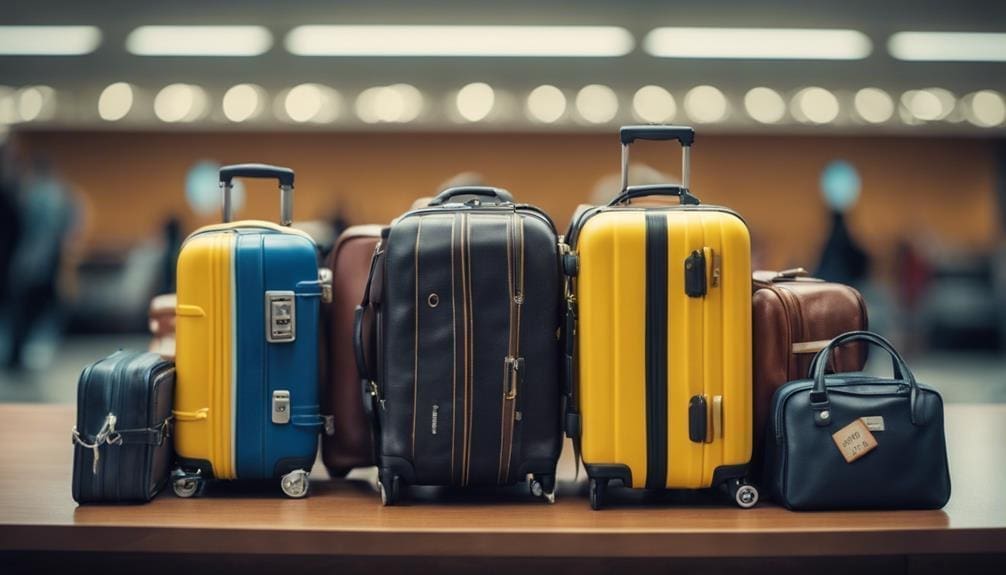To ascertain a hassle-free journey, grasping airlines’ checked baggage dimension is key. Imagine arriving at the airport, only to face unexpected charges or bag rejections due to non-compliance with size restrictions. Understanding these rules can save you from unnecessary stress and financial setbacks.
But what about those who frequently pack bulky items or struggle with weight limits? Stay tuned to discover practical tips and tricks to navigate through the maze of airline checked baggage dimension effortlessly.
Key Takeaways
- Most airlines enforce a 62 linear inch size limit for checked baggage.
- Exceeding weight limits can result in additional fees and complications.
- Airlines charge extra for oversized or overweight baggage, necessitating adherence to size restrictions.
- Familiarity with airline-specific regulations aids in avoiding excess charges and ensures smooth check-in processes.
Airline Regulations for Checked Luggage Sizes
When flying, make sure you check your airline’s specific regulations for the size of your checked luggage. Most airlines adhere to a common maximum size limit of 62 linear inches for checked baggage. However, it’s important to be aware that some airlines may have different size restrictions, which can range from 55 to 80 linear inches.
In addition to size limits, airlines also impose weight restrictions on checked bags, typically ranging from 40 to 50 pounds per bag. Exceeding these weight limits can result in additional fees.
Furthermore, airlines charge extra fees for baggage that’s either oversized or overweight. The fees for oversized or overweight checked bags vary depending on the airline you’re traveling with. To avoid incurring these additional charges and potential complications, it’s essential to understand and adhere to your specific airline’s regulations regarding checked baggage dimension.
Understanding Checked Baggage Dimension.
Understanding the dimensions of your checked baggage is important for a hassle-free travel experience. Here are some key points to keep in mind:
- Checked baggage typically has a maximum size limit of 62 linear inches for most airlines.
- Oversized checked bags may incur additional fees and charges, so it’s essential to adhere to the size restrictions.
- The standard dimensions for checked luggage are around 27 x 21 x 14 inches, meeting the requirements of most airlines.
- Some airlines may allow larger checked baggage sizes, up to 120 inches in certain cases.
Knowing the specific checked baggage size limits set by airlines is essential to help you avoid complications and additional costs during your journey. By staying within the specified dimensions, you can guarantee a smooth check-in process and avoid the inconvenience of dealing with oversized baggage issues.
Compliance With Airline Baggage Size Limits
Have you ever wondered how important it’s to comply with airline baggage size limits when traveling? Ensuring your checked bags meet the specified dimensions set by airlines is essential to avoid extra fees and complications during your journey.
Most airlines have a maximum size limit of 62 linear inches for checked baggage. Exceeding this limit could result in additional charges or the airline refusing to transport your luggage. Adhering to these size restrictions isn’t only a requirement but also plays a significant role in the efficient management of the cargo hold and ultimately contributes to passenger safety.
To help you stay within the allowable limits, airlines often provide online tools like a baggage calculator to assist you in determining if your luggage meets their requirements. By familiarizing yourself with your airline’s baggage policy and ensuring your checked bags comply with their checked baggage dimensions, you can help streamline the check-in process and avoid any unnecessary delays.
Checking Luggage Dimension Restrictions
To make sure your checked baggage dimension meets airline regulations, it’s important to double-check the dimensions before heading to the airport. Here are some key points to keep in mind regarding checking luggage dimension restrictions:
- Checked baggage size is typically measured in linear inches, with most airlines having limits around 62 inches.
- Azul Airlines stands out by allowing larger dimensions, up to 125.98 inches for checked baggage.
Exceeding the specified size limits may result in excess baggage fees being applied by the airline.
- Standard checked luggage often falls around 62 inches, similar to a Samsonite suitcase measuring 9.8 x 12.5 x 28 inches.
Guidelines for Checked Baggage Sizes
Ensure compliance with airline regulations by acquainting yourself with the guidelines for checked baggage sizes. Most airlines adhere to checked bag size limits of around 62 linear inches, ensuring your luggage fits within the overhead compartments and cargo holds.
Additionally, airlines typically enforce a weight limit of approximately 50 pounds for checked bags, so be mindful of packing efficiently to avoid excess fees for overweight baggage. Remember that oversized or overweight checked luggage may incur additional charges, so confirming the specific airline guidelines on checked luggage dimensions before your trip is essential.
While some airlines may allow larger dimensions for checked baggage, up to 120 inches in certain cases, it’s best to check with your airline beforehand to prevent any surprises at the airport.
Conclusion
So, next time you’re packing for a flight, remember to keep those checked baggage dimensions in mind.
Did you know that over 75% of airline passengers have their bags checked for size and weight compliance before boarding?
By following the guidelines set by the airline, you can guarantee a hassle-free travel experience and avoid any unexpected fees or complications.
Safe travels!














